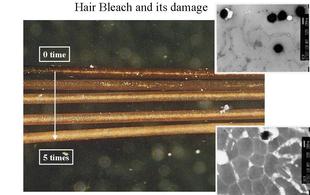Mar 25 2009
Scientists from Japan today reported development of what could be the world’s first “green” hair bleach, an environmentally friendly preparation for lightening the color of hair on the head and other parts of the body without the unwanted effects of the bleaches used by millions of people each year.
 The color changes from conventional bleach are apparent as is the corresponding damage caused to hair fibers (bottom image). Kenzo Koike
The color changes from conventional bleach are apparent as is the corresponding damage caused to hair fibers (bottom image). Kenzo Koike
Speaking here at the 237th National Meeting of the American Chemical Society, Kenzo Koike, Ph.D., pointed out that traditional hair bleaches rely on hydrogen peroxide. Peroxide is highly effective in oxidizing, or breaking down, melanin, the black pigment that gives hair a dark color.
However, peroxide bleaches have several disadvantages. “Bleach usually has to be repeated, for example, once every three months, in order to keep the satisfactory level of color because hair grows 1 cm. each month,” explained Koike, who is with the Kao Corporation’s Beauty Research Center in Tokyo. “In changing from a dark brown to a light blonde color, consumers may have to bleach several times. Repeated bleaching may compound another disadvantage of hydrogen peroxide — hair damage.”
He added that hydrogen peroxide is a harsh material. Repeated use can leave hair brittle and lifeless, with almost no attractive sheen. It also can irritate the scalp and other parts of the body.
Those unwanted effects have set scientists on a quest for milder bleaching agents, added Koike, who will discuss ways to improve color removal, including making it more effective and convenient. Koike said that his new “green” hair treatment may be the long-awaited solution.
In the ACS report, he described isolation of an enzyme from a strain of Basidiomycete ceriporiopsis, a type of “white-rot” fungus that has also shown potential to degrade and clean up pollutants in soil. The enzyme naturally degrades melanin. It has the added benefit of combating the effects of free radicals, highly reactive agents produced by hydrogen peroxide that are responsible for its damaging effects in making hair brittle, dull, and difficult-to-manage.
“I think this is the first enzyme found that degrades melanin,” he says, adding that it could be added to traditional hair bleaches to prevent hair damage, leading to hair care products that use less hydrogen peroxide.
Laboratory tests show that the enzyme is effective in bleaching synthetic melanin and melanin in human hair. Koike is working on incorporating it into conventional peroxide hair bleaches. Because the enzyme needs hydrogen peroxide to complete a chemical reaction, a small amount of peroxide would be needed for a product to work. So far, researchers are hampered by having access to only small amounts of the enzyme — a problem they expect to solve and move ahead with further tests, including clinical trials on humans.
Koike’s short-term goal is pinning down how the enzyme affects melanin. “Although I expect it can degrade melanin by its oxidation, we don’t know the mechanism of the reaction. We should examine it and test it more and more.”
The American Chemical Society is a nonprofit organization chartered by the U.S. Congress. With more than 154,000 members, ACS is the world’s largest scientific society and a global leader in providing access to chemistry-related research through its multiple databases, peer-reviewed journals and scientific conferences. Its main offices are in Washington, D.C., and Columbus, Ohio.